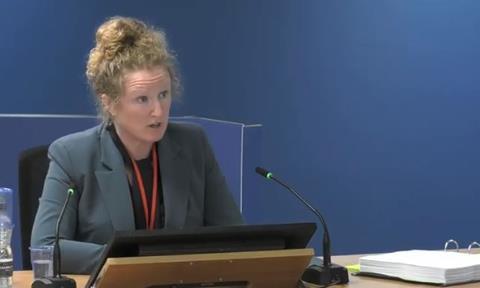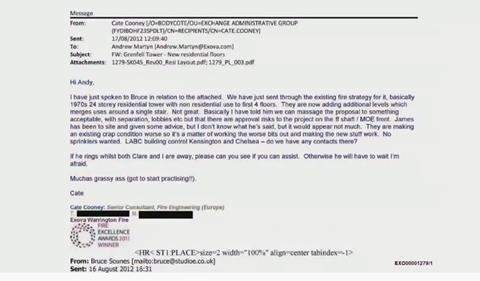Expert says Exova’s suggestion refurbishment would have no adverse impact was ‘very serious evidence of professional negligence’
Grenfell Tower refurbishment fire safety consultant Exova gave “entirely inadequate” advice to the project team carrying out the fatally flawed tower block upgrade at a time when there was confusion among contractors about safety requirements, the probe into 2017’s disaster has heard.
Inquiry expert witness Dr Barbara Lane told Wednesday’s hearing that Exova’s reports to project architect Studio E and project client Kensington and Chelsea Management Organisation failed to meet minimum standards in numerous respects. She said that the advice was professionally negligent at times.

Arup director Lane was asked to compile a report for the inquiry on the adequacy of the advice provided by Exova after it was appointed to the project in 2012 and tasked with producing a fire safety strategy for the existing building as well as one for the refurbishment.
Exova was not retained on the project after Rydon was appointed main contractor in 2014, although it continued to give advice on an ad-hoc basis.
But in her report, first submitted in May and updated last week, Lane’s overarching conclusions on the work that the specialist did undertake was that its advice was “entirely inadequate”.
She said the consultant’s “primary failing” was not looking properly at the risk of the spread of fire on external walls – a key factor on the 14 June 2017, when much of Grenfell was engulfed in flames and 72 lives were lost. The inquiry has already determined that the combustible aluminium composite material cladding and insulation added as part of the refurbishment were the reason that fire spread so rapidly across the outside of the tower.
In a day entirely devoted to the adequacy of Exova’s advice, Lane told yesterday’s hearing she stood by the view in her report that Exova’s failure to identify overcladding Grenfell was part of the refurbishment yet attesting the works would have “no adverse effect” on external fire spread – without actually analysing the proposals – was “very serious evidence of professional negligence”.
Exova’s “no adverse effect” suggestion was repeated in several generations of its fire safety strategy for the project, the last of which was published in November 2013. The assurance came with the rider that the view would be confirmed in a “future issue of the report”. The future issue was never written.
Inquiry chair Sir Martin Moore-Bick asked Lane whether it wasn’t acceptable for a fire safety adviser to say that they didn’t have any information and would deal with particular issues later.
Lane agreed that it could be helpful for a fire safety adviser to record that they hadn’t been given any information about key elements of a project, potentially as a warning sign. But she said Exova’s assurances were misplaced.
“I don’t understand how you can give a view if you haven’t seen information,” she said.
Lane accepted that a consultant would have been able to offer a view on the potential for fire to spread from one building to another without having seen detailed plans for a scheme, but not on the safety of the work itself.
She said she would have expected a reasonably competent fire safety engineer to know that the building was being over-clad and to set out as an “absolute bare minimum” the statutory guidance for insulation, cavity barriers and the external surface.
Grenfell Inquiry counsel Kate Grange QC questioned Lane about Exova‚Äôs opening statement to the probe. It argued that reports for a specialist audience that included expert architects did not need advice on the performance requirements materials needed to meet ∫⁄∂¥…Á«¯ Regulations in relation to fire spread.
“It’s no justification in my mind,” Lane replied. “Exova wrote a scope of work, offered a detailed fire strategy, were appointed to do so, and B4 [of Approved Document B, which relates to the spread of fire] is one of the five significant requirements and it required information to be provided.
‚ÄúWho gets to decide which parts of the ∫⁄∂¥…Á«¯ Regulations are either irrelevant or so well known that you don‚Äôt even need to mention them in a detailed fire safety strategy? I don‚Äôt agree that is a valid justification whatsoever.‚Äù
Grange said Exova had made the same suggestion of expertise in relation to refurbishment main contractor Rydon and facades specialist Harley, neither of which was described as needing a pointer to ∫⁄∂¥…Á«¯ Regulations.
“As the evidence shows, that was also incorrect,” Lane replied. “Harley asked some questions later and they needed to be answered. And they were not.”
Grange asked Lane if it was generally the case at the time of the Grenfell refurbishment that specialist contractors needed help with interpreting the requirements in Approved Document B of the ∫⁄∂¥…Á«¯ Regulations.
“My experience is that principal contractors and specialist cladding contractors needed assistance in understanding what the fire safety requirements were when they were going on to do their part of the job, which is the really detailed piece of work about materials and how to piece together their location,” she said.
‚ÄúIf all the professionals on the design team were well aware of the ∫⁄∂¥…Á«¯ Regulations, it doesn‚Äôt counterbalance or remove the duty that Exova had. They offered a detailed fire safety strategy and so a detailed fire safety strategy needed to be provided.‚Äù
Industry uncertainty
Lane told Wednesday’s hearing that around the time of the Grenfell refurbishment there had been a significant amount of uncertainty about fire safety requirements in relation to materials. She said that by 2013 Arup was “sufficiently worried about materials and certificates” that it started to run in-house fire and facades seminars.
“My experience in 2013 was this whole issue of contractors and other parties beseeching me saying ‘but this document says it’s class 0 and therefore it’s acceptable’,” she said.
“I was involved in many conversations, even on our own projects at Arup, trying to explain the performance of insulation.”
She added that requirements for cavity barriers to be placed around windows – which was another key safety shortfall on the Grenfell refurbishment – was also a common defect at the time.
Lane said that not all clients appointed a fire safety engineer on a project and that having chosen to appoint one, the team “should have had access to competent advice”.
“Crap condition worse”
Elsewhere in her report, Lane said an internal email written by Exova consultant Cate Cooney that described aspects of the Grenfell refurbishment proposals as “making an existing crap condition worse” had no justification. She said the exchange, which also talked about the need to “massage” elements of the project – and bluntly stated: “no sprinklers wanted” – raised serious concerns about the “absence of a recognition that protecting people is the primary goal of a fire safety engineer and the fire safety design solutions they are responsible for”.
Lane’s report noted that the “culture” the email displayed was not unique to Exova.

In her evidence yesterday, Lane also criticised Exova for failing to spend enough time surveying the condition of Grenfell Tower for its “existing building” strategy.
She said the two hours spent by staff member James Lee at the building in May 2012 was “wholly insufficient” for the task and suggested it should have been an all-day job for two people.
Lane also criticised assumptions made by Cooney in the existing building strategy that she wrote and which Lee’s site visit fed into.
Exova’s report said it had been assumed that Grenfell Tower had been constructed in compliance with the prevailing standards of the day, and that it had been maintained and that any amendments had been carried out with the approval of the regulating authority. Lane’s report said it was “wholly inappropriate” for an existing building fire safety strategy to make such an assumption.
“The whole point of an existing fire safety strategy is to be clear on what is there,” Lane told Wednesday’s hearing.
Grange asked Lane if it was wrong to assume that building works have been carried out to the appropriate standards. Lane replied: “Yes”.
The inquiry continues.



























No comments yet